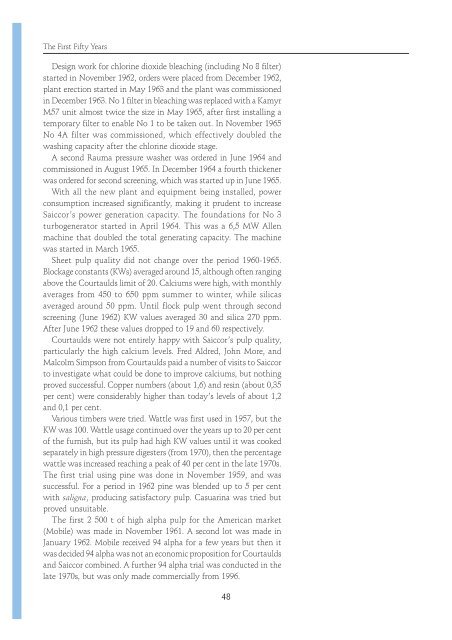Create successful ePaper yourself
Turn your PDF publications into a flip-book with our unique Google optimized e-Paper software.
<strong>The</strong> <strong>First</strong> Fifty <strong>Years</strong><br />
Design work for chlorine dioxide bleaching (including No 8 filter)<br />
started in November 1962, orders were placed from December 1962,<br />
plant erection started in May 1963 and the plant was commissioned<br />
in December 1963� No 1 filter in bleaching was replaced with a Kamyr<br />
M57 unit almost twice the size in May 1965, after first installing a<br />
temporary filter to enable No 1 to be taken out� In November 1965<br />
No 4A filter was commissioned, which effectively doubled the<br />
washing capacity after the chlorine dioxide stage�<br />
A second Rauma pressure washer was ordered in June 1964 and<br />
commissioned in August 1965� In December 1964 a fourth thickener<br />
was ordered for second screening, which was started up in June 1965�<br />
With all the new plant and equipment being installed, power<br />
consumption increased significantly, making it prudent to increase<br />
<strong>Saiccor</strong>’s power generation capacity� <strong>The</strong> foundations for No 3<br />
turbogenerator started in April 1964� This was a 6,5 MW Allen<br />
machine that doubled the total generating capacity� <strong>The</strong> machine<br />
was started in March 1965�<br />
Sheet pulp quality did not change over the period 1960-1965�<br />
Blockage constants (KWs) averaged around 15, although often ranging<br />
above the Courtaulds limit of 20� Calciums were high, with monthly<br />
averages from 4<strong>50</strong> to 6<strong>50</strong> ppm summer to winter, while silicas<br />
averaged around <strong>50</strong> ppm� Until flock pulp went through second<br />
screening (June 1962) KW values averaged 30 and silica 270 ppm�<br />
After June 1962 these values dropped to 19 and 60 respectively�<br />
Courtaulds were not entirely happy with <strong>Saiccor</strong>’s pulp quality,<br />
particularly the high calcium levels� Fred Aldred, John More, and<br />
Malcolm Simpson from Courtaulds paid a number of visits to <strong>Saiccor</strong><br />
to investigate what could be done to improve calciums, but nothing<br />
proved successful� Copper numbers (about 1,6) and resin (about 0,35<br />
per cent) were considerably higher than today’s levels of about 1,2<br />
and 0,1 per cent�<br />
Various timbers were tried� Wattle was first used in 1957, but the<br />
KW was 100� Wattle usage continued over the years up to 20 per cent<br />
of the furnish, but its pulp had high KW values until it was cooked<br />
separately in high pressure digesters (from 1970), then the percentage<br />
wattle was increased reaching a peak of 40 per cent in the late 1970s�<br />
<strong>The</strong> first trial using pine was done in November 1959, and was<br />
successful� For a period in 1962 pine was blended up to 5 per cent<br />
with saligna, producing satisfactory pulp� Casuarina was tried but<br />
proved unsuitable�<br />
<strong>The</strong> first 2 <strong>50</strong>0 t of high alpha pulp for the American market<br />
(Mobile) was made in November 1961� A second lot was made in<br />
January 1962� Mobile received 94 alpha for a few years but then it<br />
was decided 94 alpha was not an economic proposition for Courtaulds<br />
and <strong>Saiccor</strong> combined� A further 94 alpha trial was conducted in the<br />
late 1970s, but was only made commercially from 1996�<br />
48

















